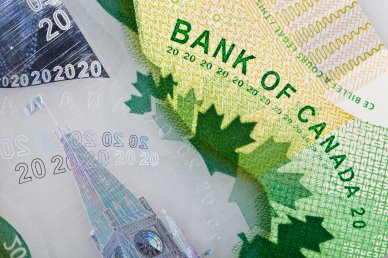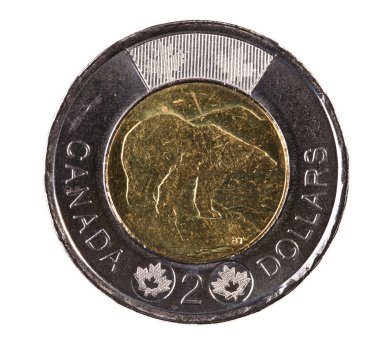The Canadian Dollar
The Canadian dollar (C$, CAD) is a freely convertible currency of tight liquidity. It is actively used in the IMF financial transactions, and thus, included in the CLS list. Many countries around the world prefer the Canadian dollar to the one of US origin in order to keep a considerable part of gold-value funds.

History
The Canadian dollar has a similar path of development to the way the US currency has undergone. Both countries are located on the North American continent. The frontiersmen from Britain, France, Holland, and even Spain began settling there around the same time.
Coins
For a long period, British pounds, US dollars, and reals released for Spanish colonies used to be the first money on Canadian territory.
Pounds were not always enough for payments. American and Spanish money confused people and created many inconveniences. Thus, in 1841, the Canadian pound was released in the province of Canada. Its ratio to the US dollar was 1:4, and to the British pound - 1:16.
However, the new currency did not turn out to be completely convenient to use. London was insisting on the uniform money while the United States was persuading Canadians to use a common currency because of the growing commodity turnover.
In 1853, the compromise was reached. The Canadian Parliament allowed the simultaneous use of the British gold sovereign and the American gold eagle coins.
Sovereign ran until 1858, even though a year earlier the Parliament of Canada had opted for the US dollar and introduced a decimal coinage connected to it. The first decimal coins appeared in 1858.
There had been no agreement on common currency among the provinces for a long time. For example, Nova Scotia and New Brunswick introduced decimal coinage and connected it to the US dollar in 1861. Later, all three provinces were united into the Dominion with a uniform financial system. In 1871, Prince Edward Island joined them and accepted the decimal coins with their connection to the US dollar.
The Newfoundland authorities agreed to adopt the gold standard in 1865 but with its connection to the Spanish dollar. Until 1893, Newfoundland minted its own gold coins. However, in 1894, the province underwent the collapse of its financial policy and switched to the Canadian monetary system.
The copper coins called tokens became fractional currency in the united provinces. As there was no official Royal permission from Britain for minting, their number increased.
Those coins were deliberately rough and looked like old worn-off money without any legend behind them. This was done deliberately so that manufacturers could not be accused of counterfeiting. Frequently, tokens had some funny names like Bouquet Su, Vexator Canadiensis, etc. There were also Blacksmith tokens, which are considered rare and of great interest for coin collectors these days.
Paper Money
The first banknotes had to be issued following the sample of the US dollar denominations because there had not been any approved currency before. They were based on the British Army notes issued during 1813-1815.
Before the 1930s, different Dominion provinces issued their own paper money. In 1935, the Bank of Canada was opened. It began the activity by issuing the banknotes in denominations of C$1, C$2, C$5, C$10, C$20, C$25, C$50, C$100, and C$500.
The money was printed in English and French languages with engravings of the Royal Family portraits.
Ten years later, only the Royal Bank and the Bank of Montreal became the two more chartered banks to issue the banknotes.
At present, the banknotes are issued by only two suppliers, the Canadian Bank Note Company and BA International Inc. They obtained this right, having entered into an agreement with the Bank of Canada - the key financial institution in the country.
Design
All the banknotes issued since 1935 can be legally used in Canada now, though their design often changed because of the rampant activities of counterfeiters. Different series were issued in 1935, 1937, 1954, 1967, 1969-1979, 1986-1991, and 2001-2004.
Besides, some banknotes are not used anymore due to their impracticality. In 1989 and 1996, smaller bills were replaced with equivalent coins in denominations of 1 CAD and 2 CAD.
Almost immediately after the release in 1935, denominations of 25 CAD and 500 CAD were withdrawn from circulation. In 2000, the release of the biggest denomination banknote of 1000 CAD was stopped; however, it was legally used till 2018. The denominations of 1 CAD and 2 CAD have also been removed from circulation because of little demand.
Design of Modern Banknotes
All paper money of Canada is of the same size and measures 152.4 mm by 69.85 mm.

A close-up of the new polymer twenty-dollar bill
The series of 1986-1991 is called ‘Birds of Canada’ and includes denominations of C$2, C$5, C$10, C$20, C$50, C$100, and C$1000:
- C$2 terra cotta banknote features the portrait of Elizabeth II on the obverse and American robin on the reverse.
- C$5 is a blue banknote that depicts Sir Wilfrid Laurier on the obverse and belted kingfisher on the reverse.
- C$10 is a purple banknote featuring Sir John A. Macdonald on the obverse and osprey on the reverse.
- C$20 is a green banknote that features the portrait of Elizabeth II on the obverse and loon on the reverse.
- C$50 is a red banknote that depicts the portrait of William King on the obverse and snowy owl on the reverse.
- C$100 is a brown banknote depicting Robert Borden on the obverse and Canada goose on the reverse.
- C$1000 is a reddish-purple banknote featuring Elizabeth II on the obverse and pine grosbeak on the reverse
The banknotes of the 2001-2004 series feature the theme of trips and have historical and cultural monuments on the obverse. There are only five samples in this series:
- C$5 - blue colour; Sir Wilfrid Laurier on the obverse and an excerpt from the hockey match on the reverse;
- C$10 - purple colour; Sir John A. Macdonald on the obverse and poppies on the reverse;
- C$20 - green colour; the portrait of Elizabeth II on the obverse and a piece of artwork of Bill Reid and an excerpt from Gabrielle Roy’s novel on the reverse;
- C$50 - red colour; the portrait of William King on the obverse and a railway on the reverse;
- C$100 - brown colour; the portrait of Robert Borden on the obverse and the maps of Canada and an excerpt from Miriam Waddington’s poem on the reverse.
Previously, Canadian paper money was printed on pure cotton, but in 2011 it was replaced by a synthetic polymer.
The Bank of Canada supervises the issuing of banknotes supplied by the Canadian Bank Note Company.
Fractional Money
In Canada, fractional currency in denominations of 5, 10, 25, 50 cents is in circulation along with C$1 and C$2 coins. Denomination of one cent has not been issued since 2013. The pennies are made of nickel, steel, and silver alloys in different combinations, and in the alloys of aluminium, bronze, and nickel.

Canadian two dollars of 2012
World Circulation of CAD
Canadian dollar holds the eighth position in the list of the world’s most traded currencies used in Forex financial transactions.
Since Canada is an exporter of crude oil, the exchange rate of Canadian currency directly depends on oil valuation. The more expensive the oil sales, the higher the CAD value.
The other factor that has a tremendous impact on Canadian currency is the American economy since the USA is a significant importer of raw materials from Canada.
